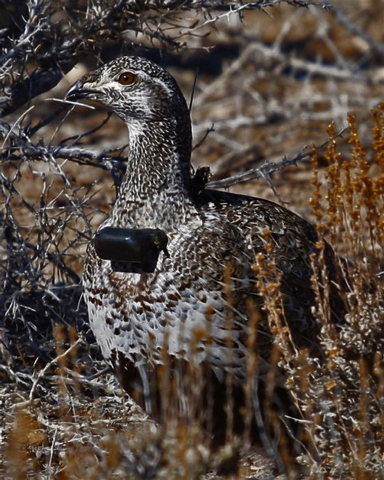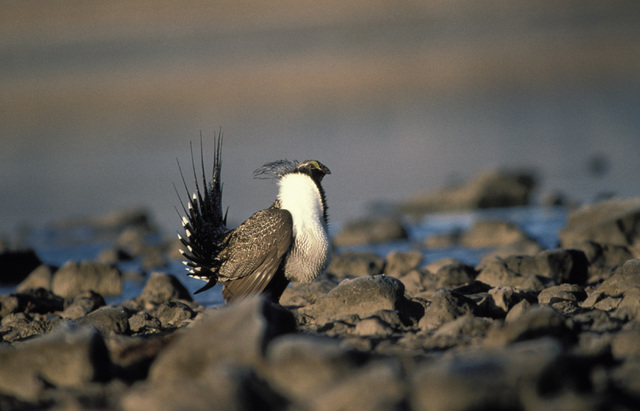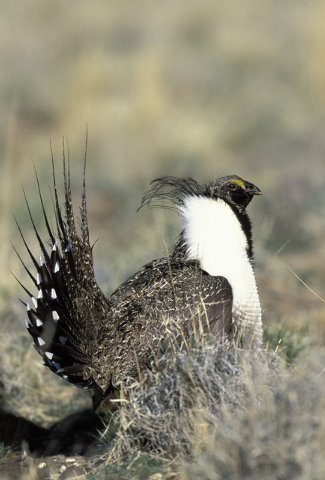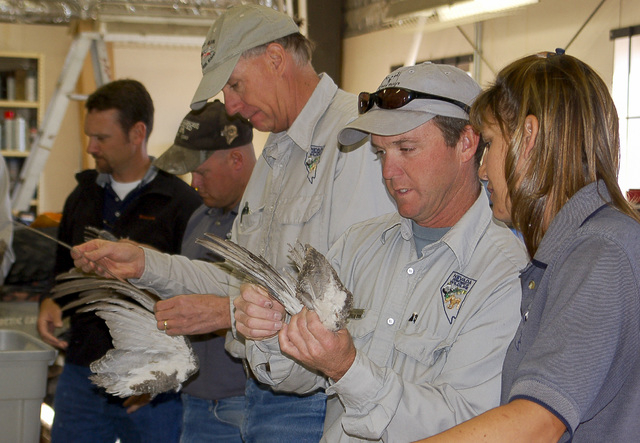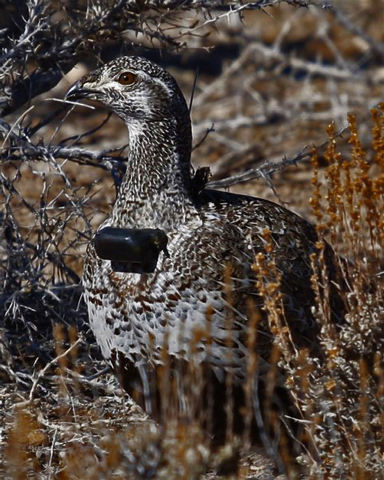Hunt is on for threatened sage grouse
As fall descends on the Great Basin, hunters are fanning out across Nevada in hopes of bagging a bird that could soon find itself on the endangered species list.
Experts say the greater sage grouse is in decline and threatened with extinction because its habitat has been splintered by wildfires, invasive plants and human land use. But this chickenlike bird is also killed by the hundreds each year in state-sanctioned hunts that have gone on for decades.
The hunting season got underway Thursday and lasts through Saturday across portions of seven counties in central and Northern Nevada. Shorter hunts in select areas have already been held or will be this weekend.
State wildlife officials won’t know until November how many sage grouse are “harvested” this year, but the number could be around 2,000, based on estimates from the last few seasons.
And Nevada is hardly alone. Sage grouse are hunted in almost every corner of their natural range from Colorado to Oregon, California to Montana.
It seems like a contradiction — killing the bird even as federal officials consider whether to add it to the endangered list. But state wildlife officials say that sage grouse hunting in Nevada is carefully managed not to harm the overall population and that the data and revenue the hunt provides directly benefits efforts to preserve the species.
Shawn Espinosa is a biologist and upland game specialist for the Nevada Department of Wildlife in Reno.
He said controlled hunting is not a threat because saving the sage grouse has less to do with individual birds or groups of birds and more to do with preserving its habitat at large. As he put it: “You can’t have sage grouse without sagebrush.”
Since 2000, wildfires have burned through more than 800,000 acres of sagebrush in Nevada.
By some estimates, the sage grouse population in the 11 Western states where it is found has declined over the past century from about 16 million to fewer than 500,000. In 2010, the U.S. Fish &Wildlife Service cited habitat loss and fragmentation as the chief cause. At the same time, the agency called on federal, state and local stakeholders to develop detailed plans for protecting and restoring the bird’s historic range to avoid an endangered species listing that has drawn widespread opposition across the West.
The clock is ticking, but Espinosa sees reason for hope.
“For a long time, people thought of sagebrush as a weed. They wanted to get rid of it,” he said. “The tide is turning in terms of Western landscape management.”
But the human response is only part of the puzzle. “There are catastrophic events that are out of our control,” things like drought and climate change that can make fires more frequent and intense, Espinosa said. “We could stand the help of Mother Nature right now.”
PERCEPTION OF ABUNDANCE
Under a court settlement with a coalition of environmental groups, the Fish &Wildlife Service has until 2015 to examine those plans and decide whether to list the bird.
Rob Mrowka is a senior scientist with one of those groups, the Tucson, Ariz.-based Center of Biological Diversity.
He said the group opposes sage grouse hunting, though he acknowledged that Nevada approaches it in a “responsible manner” that does not pose a major threat to the bird’s survival.
“The truth of the matter is the far greater threat to the grouse is climate change and habitat loss” from wildfires, livestock grazing and oil, gas and water development, Mrowka said. “Probably the biggest problem with hunting is the false perception it creates that there are plenty of birds out there, when in fact the population trend is precipitously downward.”
Sage grouse stand up to 2 feet tall and weigh between 2 and 7 pounds. The males sport spiked tails, large white ruffs around their necks and bright yellow air sacs on their chests that they inflate during courtship displays. The hens tend to be smaller and more mottled, which helps them hide in the brush with their young.
Espinosa said the state carefully sets the length and location of its hunts to prevent the birds from being “over-harvested.” The goal is for hunters to take no more than 10 percent of the breeding population, and several “pretty robust studies” show that goal is being met, he said.
Since 1997, game officials have canceled the sage grouse season in five counties and 23 separate hunting units to protect small or sensitive groups of birds.
Hunters are generally limited to four birds each. To help track size and health of the state’s grouse population, hunters are asked to remove a wing from each bird they take, wrap it in a paper lunch sack and deliver it with a short survey to the Department of Wildlife. The agency sets up about 60 “wing barrels” in hunting areas across the state to give hunters a place to drop the wings during the season.
Once the hunt is over, Espinosa and about a dozen other biologists gather in Winnemucca, usually sometime in November, for something called a “wing bee.” During the daylong event, the collected wings are counted, catalogued and examined, yielding such information as the bird’s approximate age, size and condition. By looking at certain feathers, biologists can even tell if a bird nested successfully that year.
HUNT DRAWS FEWER HUNTERS
According to state estimates going back to 1970, sage grouse hunting peaked in 1974 with about 28,000 hunters, and the “harvest” topped out in 1979 at nearly 30,000 birds.
Just six years later, amid unusually dry range conditions and a plummeting bird population, state game managers canceled the sage grouse season altogether, the only time that has happened at least since the 1950s.
Espinosa said interest in Nevada’s sage grouse hunt has “waned considerably” in recent years. According to state estimates, the 2008 season drew more than 4,500 hunters, but by 2012 the number had fallen to less than 2,000, part of a general downward trend that dates to the early 1980s.
He blames the current drop, at least in part, on the bird’s “conservation status,” which is driving away potential hunters who fear they are somehow contributing to the decline of the species.
“But if we thought that were true, we wouldn’t be holding a season, that’s for sure,” he said.
With the hunters’ licensing fees and federal matching funds, the state has spent almost $5 million on sage grouse monitoring and habitat restoration over the past 10 years.
But if the bird is added to the endangered species list, Espinosa predicted, “that would be it” for Nevada’s sage grouse hunt, no matter how much good it might be doing.
Which could help explain another trend he has noticed lately: Those still hunting sage grouse in Nevada seem more interested in bagging the largest, most well-decorated males they can find instead of birds that might make a better meal. They’re trying to grab a trophy while they still can. Even Espinosa is thinking about a trip into the sagebrush with his shotgun and his German short-haired pointer.
“I’m going to try to get out this year,” he said. “Just in case.”
Contact Henry Brean at hbrean@reviewjournal.com or 702-383-0350. Find him on Twitter: @RefriedBrean.








